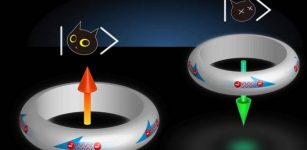Multiple Realities Exist At The Same Time – Scientist Say
Cynthia McKanzie – MessageToEagle.com – The nature of our reality has become even more complex than many previously thought and a recent study raises many fascinating questions.
For a long time, scientists have tried to find out if there is more than just one reality. Now, a fascinating study confirms the existence of multiple realities. By re-creating a thought experiment in a laboratory, physicists could demonstrate the objective reality that everyone can agree on doesn’t exist.
What you see is not the same as your friend.
So, what does it mean for us ordinary people? How it is possible that two observers are experiencing different and conflicting realities?
The study published in ArXiv is based on the famous thought experiment developed by Nobel Prize-winning physicist Eugene Wigner in 1961.
Wigner’s experiment is often used by scientists to investigate how two people can experience different realities.
Our senses, knowledge and culture determine how we perceive reality, but in the quantum world, everything gets a little more complicated.
The quantum phenomenon called superposition allows an atom to be simultaneously ‘here’ and ‘there’.
What Is The “Wigner’s Friend” Experiment?
The “Wigner’s Friend” experiment is rather simple. As Big Think explains, this is how it works:
“Wigner’s friend, a physicist, is alone inside her laboratory measuring whether a photon sports a horizontal or vertical polarization. Before she measures it, the photon exists in a state of “superposition” — that is, its polarization is both horizontal and vertical at once. After she measures it, she receives an answer. The photon’s polarization is either horizontal or vertical, not both. The superposition collapses.
As far as quantum mechanics go, that’s simple. But Wigner is standing outside the laboratory at the moment. He doesn’t know if his friend measured a photon or what that result would be. From his outside perspective, the photon and the record remain in a state of superposition.
For Wigner, the superposition stands; for Wigner’s friend, it has collapsed to a definite state. Their realities have diverged, yet both realities remain equally valid. This led Eugene Wigner to argue that a quantum measurement could not exist without a conscious observer.”
The “Wigner’s Friend” Experiment And Quantum Entanglement Tested In Laboratory
Recent advances in science have allowed researchers to test thought experiments in laboratories, and the results are very interesting.
European scientists took advantage of the “Wigner’s Friend” thought experiment and created different realities in a lab that were introduced to entangled photons so that affect on one photon must have an effect on the other.
See also:
Past Present And Future Exist All At Once – Unravelling Secrets Of Quantum Physics
In Higher Dimensions We Could See Past, Present And Future Events Simultaneously
Our World Is A Conceptual Prison And We Only See Glimpses Of Reality – Scientist Says
Quantum entanglement is one of the strangest aspects of quantum physics. It is the ability of separated objects to share a condition or state. Albert Einstein dismissed quantum entanglement as “spooky action at a distance”, but modern physics have successfully demonstrated quantum entanglement is real. Several studies have confirmed the reality of spooky action over great distances.
Scientists used “six entangled photons to create two alternate realities. One represented Wigner and one represented Wigner’s friend. Wigner’s friend measured the polarization of a photon and stored the result. Wigner then performed an interference measurement to determine if the measurement and the photon were in a superposition.
Conceptual artwork of a pair of entangled quantum particles interacting. Credit: Mark Garlick/Science Photo Library
The experiment produced an unambiguous result. It turns out that both realities can co-exist even though they produce irreconcilable outcomes, just as Wigner predicted.
“This calls into question the objective status of the facts established by the two observers,” the scientists wrote in their paper. “Can one reconcile their different records, or are they fundamentally incompatible—so that they cannot be considered objective, observer-independent “facts of the world”?
According to the principle of locality, an object is directly influenced only by its immediate surroundings. This study questions the principle.
“The experiment suggests that one or more of the assumptions—the idea that there is a reality we can agree on, the idea that we have freedom of choice or the idea of locality—must be wrong, “ Technology Review states.
This means that multiple realities do exist simultaneously. One of the most important aspects of this study is that scientists concluded there is no such thing as objective reality that everyone can agree on.
Written by Cynthia McKanzie – MessageToEagle.com Staff Writer












